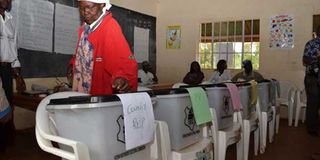Low turnout at Coast may have been Cord’s undoing

A voter casting her ballot during the March 2013 elections. The electoral commission may print the longest ballot papers for ward elections, going by the number of people eyeing slots in county assemblies. FILE PHOTO |
What you need to know:
- A document, which was posted online on Friday, shows that the Coast region, a stronghold of Mr Odinga’s Cord, registered the least turnout of just 70 per cent of the 1,171,240 registered voters
The Coast region could have been the undoing of former Prime Minister Raila Odinga’s presidential bid last year, if figures released by the Independent Electoral and Boundaries Commission (IEBC) this week are anything to go by.
The document, which was posted online on Friday, shows that the Coast region, a stronghold of Mr Odinga’s Cord, registered the least turnout of just 70 per cent of the 1,171,240 registered voters. The rest of the regions registered more than 80 per cent turnout.
The documents show that in Coast, Mr Odinga garnered 612,057 votes flooring President Uhuru Kenyatta who managed just 158,083 votes.
This means that the ODM leader could have easily forced a runoff had the turnout in Coast been slightly higher.
Mr Kenyatta managed 50.07 per cent of the total votes cast against Mr Odinga’s 40.9 per cent.
He clinched the presidency by a razor-sharp margin of 8,419 votes that helped him tip over and satisfy the constitutional requirement of 50 plus one votes to avoid a runoff.
Cord leaders, among them Mr Odinga, have, however, maintained that Mr Kenyatta did not get more than half of the votes.
They claim that some of Mr Odinga’s votes were stolen and added to the president’s tally to avoid a runoff. But they failed to prove this in court.
Citing widespread irregularities in the tallying process, Cord and the Africa Centre for Open Governance, a non-governmental organisation, teamed up in an unsuccessful petition challenging Mr Kenyatta’s victory at the Supreme Court.
Voter registration and turnout have in the past been singled out as key determinants of the outcome of elections in Kenya.
CLAIMS OF RIGGING
In January, though, Mr Odinga said that a well-orchestrated rigging — and not low voter turnout — was responsible for his loss.
“Nobody should claim that our people did not turn up to vote because that is wrong,” he said.The IEBC figures released on Friday and available on their website, show that all strongholds of Mr Kenyatta recorded a high voter turnout. Central recorded the highest voter turnout of 92 per cent with Mr Kenyatta getting 1,895,075 against Mr Odinga’s 84,010. Only 178,286 failed to vote out of the 2,195,975 registered voters.
Mr Odinga’s Nyanza stronghold recorded the second highest turnout at 89 per cent. The former PM garnered 1,508,776 votes against the 181,961 that Mr Kenyatta got. Here, 204,616 of the 1,942,138 registered voters did not show up on voting day.
However, these were cancelled out by results from Rift Valley, another stronghold of Mr Kenyatta, who had Mr William Ruto as his running-mate, which recorded a turnout of 88 per cent.
The President managed 2,188,422 votes against Mr Odinga’s 707,541. Some 423,660 of the 3,453,855 registered voters in Rift Valley abstained from the exercise. Western, which has often been accused of voter apathy, recorded a turnout of 85 per cent with Mr Odinga garnering 755,525 against Mr Kenyatta’s 66,185.
Again, 220,288 of the 1,434,573 registered voters abstained from the March 4, 2013 poll.
Both men were, however, denied a substantial number of votes in Western by former Deputy PM Musalia Mudavadi who was vying on the Amani Coalition ticket.
The documents show that Mr Kenyatta floored the former PM in North Eastern which recorded a turnout of 83 per cent of the 354,404 registered voters.
The President managed 175,032 votes against Mr Odinga’s 98,802 with 60,648 voters abstaining.
It is suspected that Coast recorded the least voter turnout because of sustained calls by the Mombasa Republican Council on locals to boycott the elections.
On voting day 14 people, among them six policemen, were hacked to death when youths thought to belong to the separatist movement attempted to disrupt voting.
And in the run-up to the election, many members of the group were arrested in night swoops.
They were also blamed for brazen daylight attacks that included the disruption in March 2012 of mock elections in Malindi organised by IEBC.
Citing historical injustices, MRC has been pushing for the Coast region to secede. Their activities have, however, slowed after a robust police operation last year.





